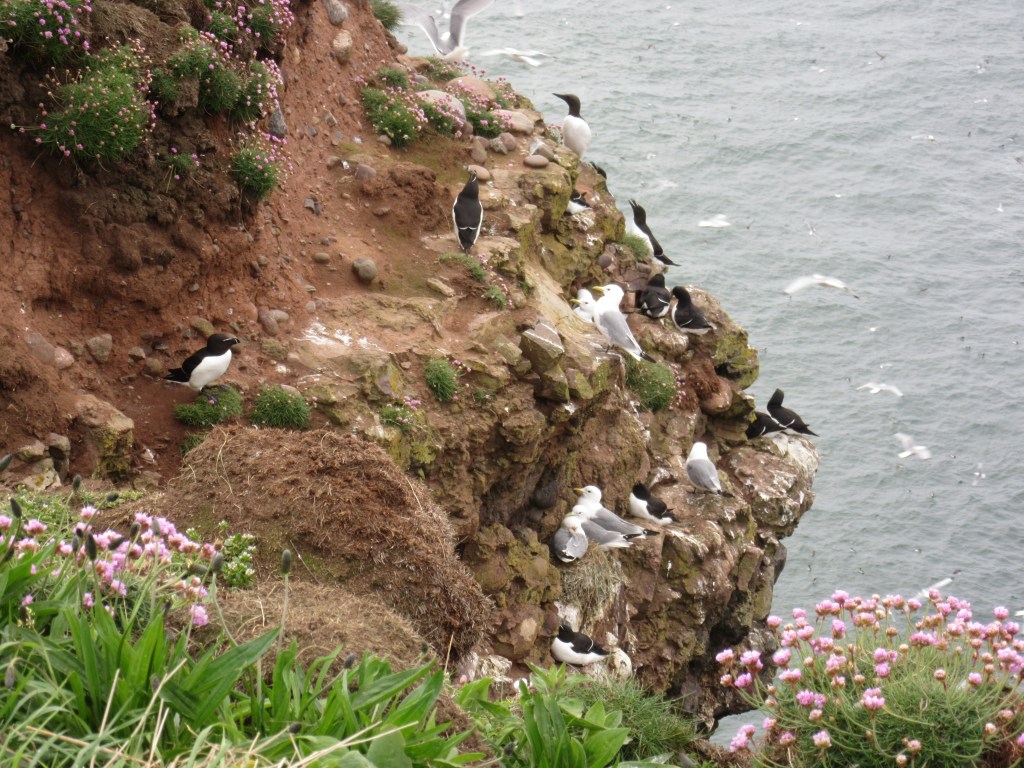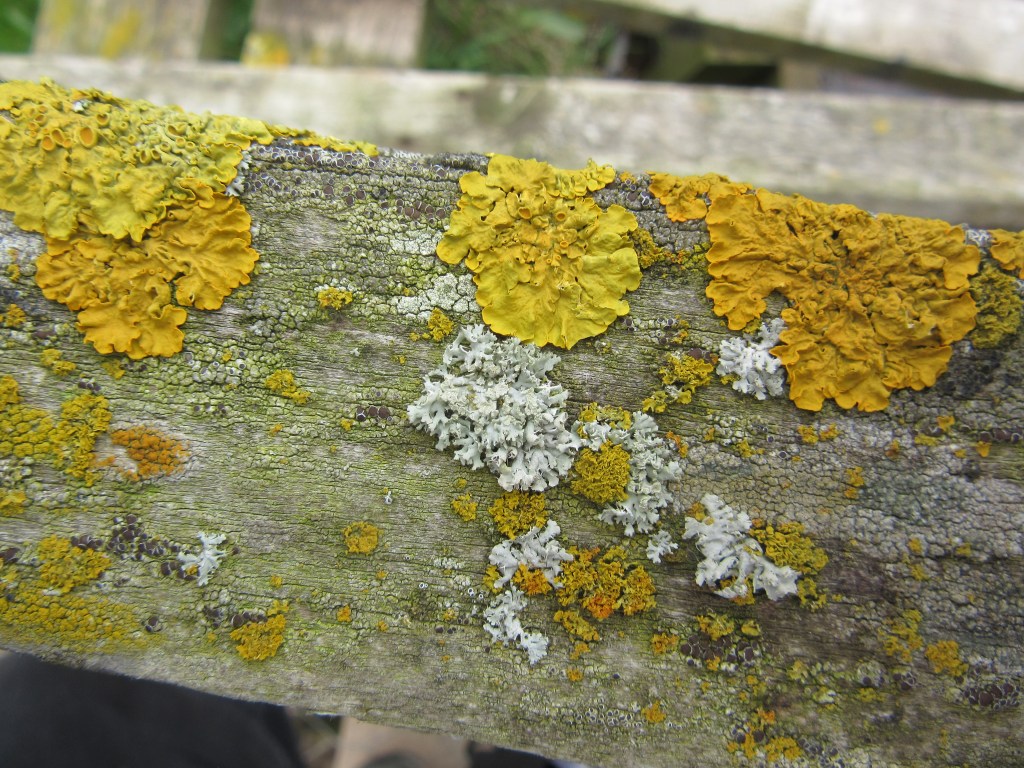In May, the coastal cliffs of the RSPB reserve at Fowlsheugh are like an overcrowded apartment block that rises from a choppy pavement all the way up to a buzzing sky. Binoculars in hand, I spent quite some time distracted by the squabbles and rumours squashes that unfold beneath me. The volunteer warden looks slightly bemused when I explain that I haven’t come to look at the birds, but have an interest in lichens.

True, it would have been more efficient had I planned this trip outwith the breeding season, but spring is a good time to look for lichens on the clifftop. The vegetation is waist-high, the red campion flowers abundantly and the thrift turns the upper ledges pink. Yet, the buzz of bees and hoverflies, butterflies and moth is completely sounded out by the calls of kittiwakes and fulmars, guillemots and razorbills that seems amplified by the steep rising cliffs. The smell of the excrements that have turned the cliffs white irritates and early on I decide to eat my lunch somewhere else.

With binoculars I scan the side of the cliffs for lichens. Only those rocks that are not topped by a ledge seem to have some yellow cover of what appear to be Xanthoria and Caloplaca species and the texture of Ramalinas. Along the clifftop path there are only few rocky ledges, and the vegetation needs to be bent back to reveal some of the Anaptychia runcinata, Diploicia canescens, Lecanora campestris, Ochrolechia parella and Tephromela atra on them. I even found some of the rarer Lecania aipospila, a species that is associated with perching birds. By far the most prolifically covered with lichens were the many fenceposts. The yellow Xanthoria parietina and Candelariella vitellina were abundant alongside the pale Physcia caesia and Physcia adscendens. In Scotland, these species are found by the dozen. More surprising was the find of large and conspicuous patches of the usually saxicolous Caloplaca verruculifera on fenceposts and the much more subtle Rinodina oleae on the plastic pipes that are meant to protect from them.
At first sight, most of these finds do not rock the world, but going beyond the species list and looking at their relative abundance reveals a picture of cliffs covered in lichens that cope well with eutrophication caused by seabirds. Species like Candelariella vitellina and Physcia ceasia are ubiquitous in nutrient-rich environments on the coast and inland, but Lecania aipospila and Caloplaca verruculifera are specifically associated with the eutrophication caused by perching birds, that is, species one would expect to thrive near seabird colonies.

The management guidelines for lichens in seashore environments drawn up by the British Lichen Society acknowledges that ‘encouraging birds to nest or roost will certainly change the lichen communities’ and it discusses this in terms of competition and conflict. Standing on the clifftop at Fowlsheugh I can see where these comments come from. The excrements of nesting kittiwakes, fulmars, guillemots and razorbills have created a toxic environment on the sides of the cliffs and disturbed this environment so much by trampling that lichens have little chance to gain foothold. The eutrophicated environment that their excrements created also means that the herbaceous vegetation on top of the cliffs grows so abundantly that the few rocky ledges present are rather shaded and vegetation needs to be bent back to see if any lichens persist beneath. But I would probably not use the terms competition and conflict to describe this. The Aberdeenshire coast is known for its seabird colonies and these seabird colonies were enabled by a combination of a geology that involves steep cliffs with plenty of rocky ledges for breeding and plenty of fish in the sea below to feed the young. From the perspective of a single species (or species group) the presence of those bird colonies hinder the lichen assemblages to reach their full potential. As an ecologist I would prefer to say that the geology and availability of fish have created the conditions for thriving seabird colonies, which, in turn, have created a hyper-eutrophicated environment that has given rise to a lichen assemblage that comprises common eutrophication indicators and species characteristic for bird-perching along the coast. If, this spring, birds would not return to those cliffs to nest, this lichen assemblage would eventually disappear with species with a more limited distribution, such as Lecania aipospila and Caloplaca verruculifera, losing important habitat. In his article collection Claxton, nature writer Mark Cocker questions our obsession with rarity. Though many of the lichen species on the seacliffs at Fowlsheugh may be common, we should perhaps celebrate their presence and abundance as a unique reflection of a finely balanced ecosystem in which geology, fish and seabirds play a principal role.
Click here for a picture gallery of coastal lichens.
Sources
Cocker, M., 2015. Claxton. Field Notes from a Small Planet. Vintage, London.
Dobson, F.S., 2014. A Field Key to Coastal and Seashore Lichens.
Ellis, J. C., 2005. Marine birds on land: a review of plant biomass, species richness and community composition in seabird colonies. Plant Ecology 181: 227-241.
Fletcher, A., 1973. The ecology of maritime (supralittoral) lichens on some rocky shores of Anglesey. The Lichenologist 5: 401-422.
Smith, C. W. et al, 2009. The Lichens of Great Britain and Ireland. The British Lichen Society. Second edition.
Wolseley, P. A., P. W. James, B. J. Coppins, O. W. Purvis, 1996. Lichens of Skomer Island, West Wales. The Lichenologist 28: 543-570.
Copyright text and images Petra Vergunst
One thought on “Fowlsheugh: lichens in a seabird colony”